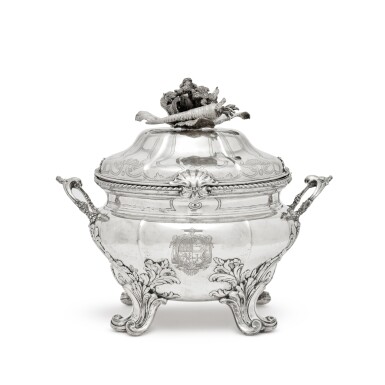The Pleasure of Objects: The Ian & Carolina Irving Collection
The Pleasure of Objects: The Ian & Carolina Irving Collection

A Rare German Silver Pot À Oille, Johann Hues, Hamburg, 1769-1782 mark
Auction Closed
January 30, 06:14 PM GMT
Estimate
40,000 - 80,000 USD
Lot Details
Description
circular, on four scroll feet with foliate brackets leading to the asymmetrical rococo scroll handles, the cover with chased ornament and carrot, pea and broccoli handle, the interior with removable liner, the body engraved with the arms of Woodford of Carleby, Lincolnshire, marked on cover, finial, base and liner
141 oz; 4385 g
height 12 1/4 in.; 31 cm
Johann Hues was born in Wilster in 1632 and made the short move to Hamburg in 1767. He passed control of the business over to his son Christopher Bernhard in 1802. The present lot is one of his earliest pieces: Die Goldschmiede Hamburg illustrates 13 items with his mark, all of which are later and all in a neoclassical style. This pot à oille is the only known example of his work in the rococo style.
Silver pots à oille and soup tureens are rare for 18th century Hamburg. In Die Goldschmiede Hamburg, Erich Schliemann illustrates a pair by Johann Conrad Otersen 1784, vol III, pl 482, p.203 and a single on stand in Empire Style by Johann Hues circa 1800, vol II no.486, illus. vol III, pl.483, p.203; he only lists three others.
The arms are those of Woodford of Carleby, Co. Lincolnshire for Ralph Woodford (1734-1810), diplomat. He started his career as in 1758 in Turin as private secretary to the Earl of Bristol, a renowned connoisseur of silver whose ambassadorial plate is preserved at Ickworth, including two circa 1756 pots à oille made in Turin to match his Frederick Kandler soup tureens. Woodford was then named secretary to the British Embassy in Spain, serving from 1760 to 1762; the ongoing Seven Years War (1756-63) placed a renewed importance on British diplomacy on the Continent. In Madrid he may have acquired a Spanish or imported French silver pot à oille, which taken to his next post in Hamburg was then copied by a local silversmith. Woodford served there as British Resident to the Hanseatic Cities from 1763 to 1772, and it was likely during this time that acquired the present lot, a form still unusual in North German silver.
Woodford continued his career by being named Charge d'Affaires at the court of Denmark in July 1772, succeeding Robert Keith. This was a difficult position, as the former Queen of Denmark was Caroline Matilda, sister to George III. Earlier in the year she had been divorced by the King and her lover J.F. Streunsee executed; Keith had helped negotiate the release of the British-born princess to exile in Celle. Woodford’s arrival was a sign of Great Britain’s attempt to normalize relations between the two courts after this unfortunate family affair.
Woodford returned to England in 1774, and was working on trade agreements with Spain in 1785. In 1791 he was created 1st baronet of Carlby. And the same year was named Commissioner to Spain, leaving this last post in 1795. His son Ralph-James, born 1784, was a respected Governor of Trinidad and died in 1828 whereupon the baronetcy became extinct.
